#Vol 188
Explore tagged Tumblr posts
Text

[6]
It’s been a while (years?) since this the last world where he could do this but I absolutely adore when Fai comes out and says all the detailed observations about the location outloud. THANK YOU FAI I LOVE IT.
I'm also THRILLED that Yukito is back in the narrative, if only in reference. Yet another tie back to the beginning of the manga and a reason to remember everything that happened in Chapter 1 to prepare for whatever follows this moment.
Though it’s interesting that Sakura was being prepared to take over the position of High Priest, considering Yukito knew she wasn’t really going to be available for that, and presumably so did Clow. Did Yukito just go along with it so that Sakura didn’t know what her future would be like? Or is there still some time shenanigans in play here and this is from an alternate place in time where they DIDN’T know about Sakura’s tragic fate?
We just don’t know!
(just kidding it’s only me)

MOKONA CRACKED THE CASE!
Our little detective trying so hard to contribute to the plot HAS DONE IT! She asked the question that unlocked the backstory. I’m so proud.
And the DARKNESS in that panel when Lava Lamp says Always! The tragedy! The drama! OOH I love it.
However the possibility of further timeline shenanigans are swinging right around back to 100% oh dear god here we go
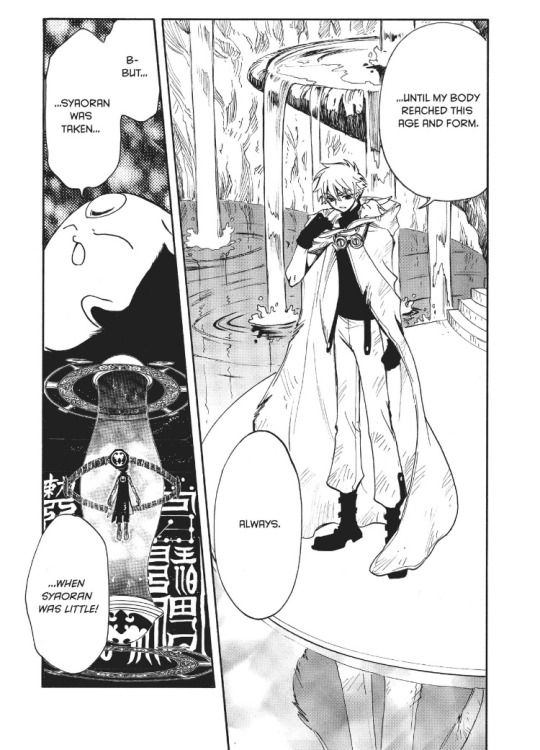
OH GOD EVERYONE HOLD ON TO SOMETHING WE’RE PLUNGING OFF THE CLIFF INTO OUR DOOM HERE WE GO
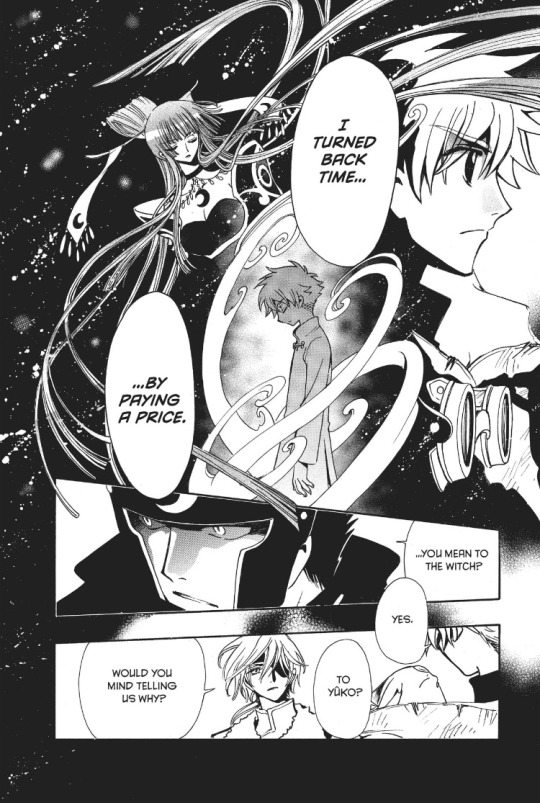

AHHHHH GOD DAMNIT
NOW HOW AM I SUPPOSED TO KEEP TRACK OF A SINGLE THING THAT HAS EVER HAPPENED?
#PLEASE HOLD#PLOTLINE PROCESSING#Liveblogging the Reservoir Chronicle#Vol 188#Tsubasa#Lava Lamp Guy#Sakura#Sakura 1 or Sakura 2? Sakura 0?#Mokona#Kurogane#Fai#And TIME TRAVEL#Ok ok ok ok ok okokokokokok#Okkkkkkkkkkkkkkkkkkkkkkkkkkkk
64 notes
·
View notes
Text

20 notes
·
View notes
Text
i am having a hard time taking mr 3 seriously in little island now that i have seen him running around with buggy in impel down lmao
2 notes
·
View notes
Text

ロッキング・オン・ジャパン 2000年6月号 VOL.188 ロッキング・オン 表紙=BLANKEY JET CITY
#ロッキング・オン・ジャパン 2000年6月号 VOL.188#ロッキング・オン・ジャパン 2000年6月号#ROCKIN’ON JAPAN#ロッキング・オン・ジャパン#blankey jet city#ブランキー・ジェット・シティ#anamon#古本屋あなもん#あなもん#book cover
9 notes
·
View notes
Text
the yotd art exhibition has me acting UNWISE on ebay dot com…………
#luckily (for my bank account) most of the stuff’s way way WAY too expensive for me#but i can and do sniff out any reasonably priced listings :3#i’d give anything for this one keychain set tho…..except the $188 it’s going for bc that’s deranged#u wave the vol 42 cover art in front of MY face and then u slap me with that insane price?? evil. EVIL!!!!!!!!!
4 notes
·
View notes
Text
Scarlet Witch reading guide

This is not meant to be a comprehensive list of every appearance, but a walkthrough of what you need to read to understand Wanda's lore, history, and personal life events. I also have a breakdown of the Maximoff's powers and an explanation of their parentage and ethnic background. [This is an updated + condensed version of this post-- the formatting is messed up and I can't edit it, so I made a new one]
X-Men Vol 1 #4-11-- Wanda & Pietro's first appearance as teenage mutants & Brotherhood members.
Avengers Vol 1 #16-27-- The twins join the Avengers. Known as the "kooky quartet" era.
Avengers Vol 1 #91-108-- Wanda begins a romantic relationship with Vision
Avengers Vol 1 #128-133-- Wanda meets Agatha Harkness and begins studying witchcraft.
Giant-Size Avengers #1-4-- Wanda meets Robert Frank and believes he is her father; Wanda and Vision get married.
Avengers Vol 1 #181-183-- introduces Django Maximoff.
Avengers Vol 1 #185-188-- also known as Nights of Wundagore, the twins return to Transia and learn about their birth on Mount Wundagore & the origin of Wanda's powers; Wanda is possessed by Chthon.
Vision & the Scarlet Witch Vol 1 & 2-- Wanda & Vision acclimate to married life. Pietro's daughter Luna is born; the twins learn that Magneto & Magda are their birth parents; Wanda becomes pregnant and gives birth to twin boys.
Avengers West Coast #42-62-- includes Vision Quest & Darker Than Scarlet storylines. Vision's memories and emotions are erased; the babies are destroyed by Pandemonium and Mephisto; Wanda learns that she is a Nexus Being while suffering the manipulations of Immortus.
Force Works (1994)-- Wanda acts as team leader and begins a relationship with Simon Williams.
Scarlet Witch (1994)-- a miniseries which introduces Lore and expands on the concept of Nexus Beings.
Avengers Vol 3 #1-3; 10-11-- Wanda learns more about chaos magic and resurrects Simon Williams.
Avengers Vol 1 #503-507-- a storyline titled Chaos, which kicks off the Avengers Disassembled crossover. Wanda suffers an apparent mental breakdown and causes a series of calamities as her powers escalate to uncontrollable reality-warping.
House of M-- a sprawling crossover event set within an alternate reality of Wanda's creation; concludes with Wanda inadvertently erasing a large percentage of the mutant population. This is referred to as the Decimation, or M-Day. Wanda disappears and remains missing for several years.
Young Avengers; Young Avengers Special; Young Avengers Presents: Wiccan & Speed-- introduces Billy Kaplan and Tommy Shepherd, who learn that they are Wanda's reincarnated sons and begin searching for her.
Avengers: Children's Crusade-- the Young Avengers, Magneto, and Quicksilver discover Wanda as an amnesiac living in the care of Doctor Doom. They help her recover her memories and her powers are returned to normal.
Avengers vs. X-Men-- Wanda rejoins the Avengers. Alongside Hope Summers, Wanda helps banish the Phoenix from Earth and causes a proliferation of new mutant to manifest, the first step in her redemption for M-Day.
AXIS-- Wanda & Pietro learn that Magneto is not their father after all, and they're not actually mutants.
Uncanny Avengers Vol 2 (miniseries)-- the twins learn that their powers are the result of the High Evolutionary's genetic experiments.
Scarlet Witch (2016)-- Wanda returns to her magical focus and has henceforth been written as an adept spellcaster. The series does a lot of worldbuilding around witches and witchcraft. The twins learn that their birth mother was actually Django's sister, Natalya Maximoff, and that they are descended from a lineage of Scarlet Witches.
Doctor Strange (2016)-- Wanda is featured in the Last Days of Magic storyline.
Uncanny Avengers Vol 3 #26-30-- Wanda rejoins the Avengers Unity Division and begins a relationship with Doctor Voodoo.
Avengers Vol 1 #675-690-- a crossover event titled Avengers: No Surrender.
Quicksilver: No Surrender-- an excellent miniseries following the previous event. Wanda and Jericho use magic to aid Pietro.
Avengers: No Road Home-- a sequel to No Surrender.
Strange Academy-- Wanda becomes a faculty member at a school for young magic users.
Darkhold (2021)-- the original Darkhold is discovered; Wanda's prior experiences have made her strong enough to handle it without corruption; she merges the Darkhold with her own soul and uses it to bind Chthon.
Trial of Magneto (2021)-- Wanda stages her own death as part of an elaborate scheme to gain access to, and magically enhance, the Krakoan resurrection system, leading to her final redemption for M-Day.
Scarlet Witch (2023)-- Wanda opens a metaphysical shop in upstate New York and constructs a magical portal called the Last Door. New friends, enemies, and a new status quo are introduced.
Avengers (2023)-- Wanda joins a new iteration of the Avengers, led by Captain Marvel.
Contest of Chaos-- a crossover event. Agatha attempts to create a new Darkhold, much is revealed about the origin and nature of chaos magic.
Scarlet Witch & Quicksilver; Scarlet Witch (2024)-- a special anniversary miniseries which leads into the solo title relaunch. The twins are hounded by an abstract entity called the Griever and begin to expand their powers beyond their previous limitations; new context is given to Nexus beings; Chthon escapes containment.
116 notes
·
View notes
Text




BUCK-TICK FOOL'S MATE August 1991 Vol.188
90 notes
·
View notes
Text
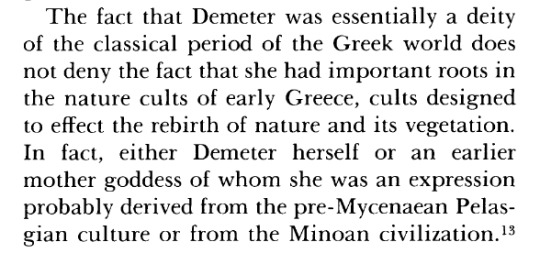


Isis and Demeter: Symbols of Divine Motherhood
Author: Vincent Arieh Tobin
Source: Journal of the American Research Center in Egypt, Vol. 28 (1991), pp. 188-89, link
#i love demeter sm#demeter#demeter worship#persephone#persephone worship#demeter deity#hellenic polytheism#helpol#hellenic reconstrunctionism#still reading this paper so the verdicts still out. still - interesting argument I thought to share#never heard of this comparison before but maybe worth looking into
215 notes
·
View notes
Text
“Yatagarasu” characters and their ages+ when the anime has begun *




Wakamiya/Nazukihiko, 16/17 years old (from the novel Vol 2/Vol 5) upon meeting Yukiya. I must add that character designer Takumo Norita canonically made that Wakamiya stands 188 cm tall despite his young age. Chisato Abe wrote: “Yukiya heard that His Highness was sixteen or seventeen years old, but for his age he turned out to be quite tall and slender.” (His possible birthday month could be August/summer, Shōwa 45. In 1995, he was said to be 25 years old. **)
Yukiya, 13 years old at the start of the episodes, but turned 14 (his birthday probably falls in spring, 1974**) after his stint in the Ravine/Taniai (from the novel Vol 2, manga, and the short story, “Thinking of Fuyuki” ). Yukiya, on the other hand, is small for his age, according to Wakamiya and Rokon. The boy stands 150 cm tall in the anime, while mangaka Natsumi’s rendition says that Yukiya is three centimetres lower, 147.
Sumio, between 18 and 19 years old (he finished the three-year rigorous education program from the Keisoin Academy and was the top of his class. Children usually enter this institution when they are 15 years of age.)
Natsuka, 21/22 years old (from the novel Vol 2 and anime)
The Princesses/First Arc



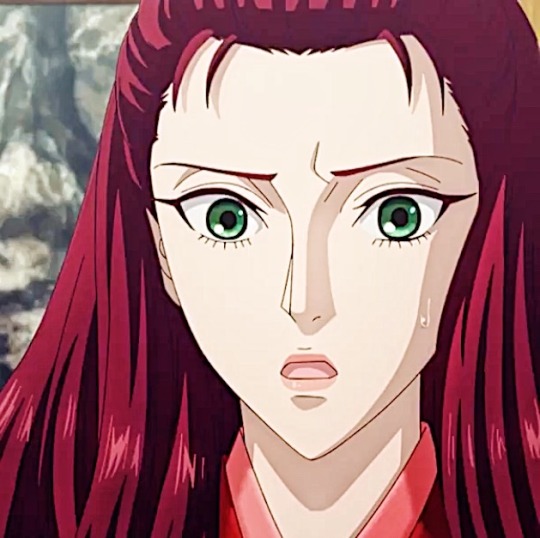
Asebi, 18 years old (from the fan book), has turned 19 at the time for Wakamiya’s bride selection. Chisato Abe wrote on the fan book that Asebi and Hamayu are of the same age.
Hamayu, 18 years old (from the fan book), must have turned 19 during the bride selection
Masuho no Susuki, 16/17 years old (from the fan book)
Shiratama, 14 years old (from the anime), has turned 15 for the next spring
Others
Yukima, 14 years old but will turn 15 that year to celebrate his coming of age during the New Year’s banquet with the North House first couple (from the manga Chapter 2)
Fujinami, 12/13 years old
Yukichi, 8 years old (from the manga)
Kazumi, 18 years old (from the manga and novel)
The Golden Raven arc


Yukiya, now 15 years old (Chapter 2 of the Book 3: The Golden Raven), he left Wakamiya’s service only to return to him, but this time voluntarily
Koume, 15 years old, the same age as Yukiya
*Subject to change
** Source: Volume 5: Tamayorihime (The Girl for God) (Timeline happens in 1995, calculating back, it seems that Nazukihiko was born in 1970, when it says that he is 25 years old in the book. Yukiya, on the other hand, was born in 1974.)
#yatagarasu#yatagarasu series#the raven does not choose its master#wakamiya#yukiya#sumio#lord natsuka#asebi#hamayuu#masuho no susuki#shiratama#yukima#yukichi#kazumi#koume#the golden raven arc#yatagarasu reference#karasu wa aruji wo erabanai#these are all ‘80s kids
64 notes
·
View notes
Text
A literal rant lmao
Y'all, please learn to find source for something you read online ...
I have been quite active in other fandom before but i never seen so many misinfo spreading like willfire than kny fandom pls 😭
Iguro DID NOT keep ring in his estate for mitsuri y'all he deem himself unworthy and only accept her proposal for their NEXT LIFE. Pls read chapter 188 carefully y'all. <---- the irk i found about this popular hc is stonk bc this is clear mischaracterization of him. Iguro is soooo broken even though he found light in Mitsuri, he couldn't freeing himself from his self loathing 😭
The other popular hc like burying together, i find it cute but its not canon y'all and i feel like burying them separately is more appropriate plus they usually cremating their dead like zenitsu's gramp.
Another popular hc that people treat it like canon that irked me is regarding shinobu didn't tell giyuu only and telling other hashira. Noooooo they'll against it too why do you thing gyomei or Mitsuri, her bestie will allow it???? The only canon one is she telling kanao, That's it. 😭💔
If u writing headcanon, pls tell people honestly it's just a hc nothing more don't treat it like canon. I was wondering for a bit when i read all this where tf y'all found this info.
There's this canon source that y'all need to read/cross checking . Unless it was stated in this sources, whatever you read online is a headcanon 🥲
The whole manga
Anime original scene. (Yes it's canon and tight up some missing connection in the manga)
Gaiden (giyuu and rengoku)
Light novels
Corps record (official fanbook there's 2 vol if im not mistaken)
Taisho secret.
Official interviews from Gotouge (I'm not sure if there's any)
Sorry to breaking your heart obamitsu lover but here a bit anecdote from light novels as a compensation 🙏
Iguro was so worried about Kanroji's less appetite and he aware sth was troubling her. She got a little injury in her face and he get angry and want to kill the demon who did it before kanroji explained that she's already kill it. (Butterfly wings ln if I'm not mistaken) -this LN is also deal with mitsuri and shinobu close relationship and it's really cute 🥰.
When discussing about the consequences of the marks, gyomei expressed his worry on muichiro as he was so young and asked if he's okay. Muichiro telling him he may be a bit concern about it but asked gyomei back why shouldn't he worry about mitsuri, or iguro? Gyomei wonder why he brought up iguro and muichiro telling him that he was obviously in love with mitsuri. In this specific convo, gyomei aware that muichiro has become more observing and opened up to them which he was glad to see. Also this implied that the two were like a lovebirds to everyone else (except sanemi maybe bc he canonically dense about relationships) but they aren't aware lol. (Chap 4 of The Wind's Telltale Signs LN)

#demon slayer#kimetsu no yaiba#kny headcanons#light novel#canon#rant post#obamitsu#obanai iguro#mitsuri kanroji#obanai x mitsuri
24 notes
·
View notes
Text
Causes of forgetfulness
A big cause of forgetfulness - the bane of knowledge, is sin which weakens memory. Therefore, Sayyiduna Imam Shafi’i رَحْمَةُ اللّٰهِ عَلَيْه has stated:
شَكَوْتُ إِلىٰ وَكِيْعٍ سُوْ ءَ حِفْظِی
فَأَوْصَانِيْ إِلىٰ تَرْكِ المَعَاصِيْ
فَاِنَّ العِلْمَ فَضْلٌ مِنْ الٰہٍ
وَفَضْلُ اللّٰهِ لَا يُعْطیٰ لِعَاصِی
Translation: I made a complaint about my weak memory to my teacher Sayyiduna Wakee’ رَحْمَةُ اللّٰهِ عَلَيْه. So, he advised me to leave off (committing) sins since knowledge is a blessing from Allah عَزَّوَجَلَّ, and Allah’s blessings are not bestowed upon a sinner. (Ashi’at-ul-Lam'aat, vol. 1 pp. 188)
19 notes
·
View notes
Text

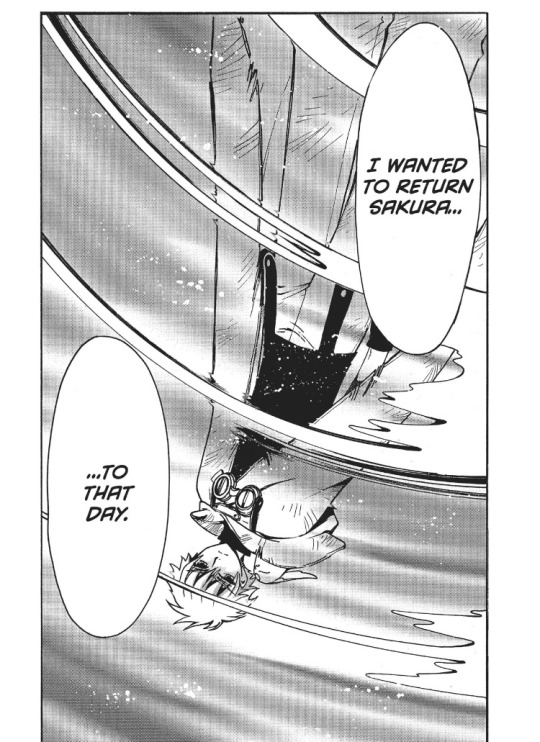
[7]
OK LAVA LAMP LET’S SIT DOWN FOR A MOMENT
YOU TURNED BACK TIME??
I’m sure we will get more about this next week but WHAT DO YOU MEAN?
DID YOU TRAVEL BACK IN TIME BY YOURSELF, INTO YOUR OWN TIMELINE, OR DID YOU SOMEHOW PAY ENOUGH TO REWIND THE ACTUAL TIMELINE ITSELF TO THE POINT WHERE YOU WERE ABOUT TO TURN SEVEN?????
WHAT WOULD EVEN BE ENOUGH TO PAY FOR THAT?
I’m reeling what does this even mean. Is ALL OF THIS just Round Two of the plotline? Did Lava Lamp and Sakura just grow up happily in Clow until they got to [insert age here] before he turned back time to start it all again?
Or did Evil Wolverine’s influence happen that time too, and he ALSO went on a journey to save Sakura and this is actually the second time it’s all happened?
And what is it exactly that Lava Lamp is trying to prevent? What happens to Sakura that he rewinds time all the way back? It would definitely line up with Evil Wolverine’s timing, but it might not necessarily be that.
What was he supposed to have figured out here, at this point in the timeline, like he mentioned before? And did he mean when he was genuinely 6 years old or when he was 6 years old the second time and so secretly not 6 years old at all?
Did 2nd Time Around 6 Year Old Lava Lamp KNOW something about the plot that he could have figured out here, with context? And he laments not putting the pieces together?
LAVA LAMP I THOUGHT I WAS SO CLOSE TO ACTUALLY UNDERSTANDING YOU AS A CHARACTER AND NOT ONLY WAS I WAY OFF BUT NOW I GENUINELY HAVE NO IDEA WHAT’S EVEN HAPPENING
THANKS.
#WHAT#W H A T#LAVA LAMP YOU CAN’T JUST-#Actually it appears you actually can just#Oh boy#I will genuinely draw a timeline map if I have to#Liveblogging the Reservoir Chronicle#Vol 188#Tsubasa#Sakura#Lava Lamp Guy#And Time Travel#Do we think Evil Wolverine HAPPENED in that original timeline#So Lava Lamp turned it back#Only for Evil Wolverine to start messing with dimensions?#Or was that always his game?#And IS Lava Lamp's Sakura still around?#Or was she also rewinded by the timeline?#Meaning she kind of doesn't exist?#HMMMMM
65 notes
·
View notes
Text



2015's Silver Surfer Vol.7 #9 (LGY : #188) cover by Mike & Laura Allred.
#Silver Surfer#Galactus#Dawn Greenwood#Dan Slott#Mike Allred#Laura Allred#marvel now#norrin radd#cosmic beings#cosmic comics#marvel comics#cool comic art#cool cover art#comics#cover#2010s#silver surfer comics#herald of galactus#marvel#the Devourer of Worlds#to me my board#art#silver surfer by Dan Slott & Mike Allred#the devourer#Norrin Radd & dawn greenwood#master vs herald#comic books#silver surfer vs galactus#2010s comics#galan of taa
17 notes
·
View notes
Text
RKRN Komatsuda Yuusaku Appearances (w/summaries and translations)
The older Komatsuda brother has appeared sporadically throughout Nintama Rantarou over the years. Unfortunately, he was excised from several of the anime adaptations of manga chapters he appeared in, so people who haven't read the manga aren't getting all the Yuusaku content that they deserve. That's a problem which needs fixing!

Like my previous Rikichi+Komatsuda RKRN guide, I put together a little something showing all the times Yuusaku appears in the manga, with summaries and translations.
Quick list:
Vol 32, pages 31-32, 34, 36-37, 39, 42 Vol 33, page 188 Vol 35, pages 43-49 (voice appears on page 52) Vol 38, page 240 Vol 41, pages 30, 146-147, 154, 161 Vol 47, pages 126, 180 Vol 65, pages 11-15, 63-65, 67-70, 72, 82, 86, 89-90, 102, 107, 109, 119, 127, 148, 221-223, 235
Summaries and translations
Vol 32
Pages 31-32, 34, 36-37, 39, 42
Yuusaku's first appearance - and he didn't even make it into the anime adaptations of these chapters (episodes 11-22~24, 11-76~78)!
Komatsuda comes across a leaflet advertising ninja work and, still hoping to be a professional ninja, goes to find if he can get a job. He brings his brother with and runs into Rantarou, who came with his mother.
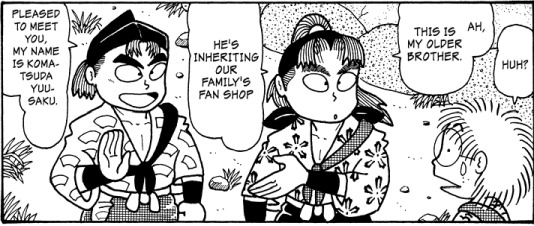
They meet up with everyone else looking to find work and are given their task: they must sneak into a certain castle’s outpost and retrieve some hidden documents. Rantarou spots Dokutake ninja among the job-seekers, raising his suspicions. Dokutake ninja would never go looking for other ninja work, he says; according to what Yuusaku has heard, Dokutake castle pays well. Perhaps that's something Yuusaku learned when Komatsuda went to take Dokutake's employment exam?
Yuusaku gets one more line, asking if Rantarou knows one of the ninja they meet. After that, Rikichi disguises himself as Yuusaku and takes the man's place without anybody else knowing. Where did Yuusaku go? Home, most likely. I like to imagine Rikichi pulled Yuusaku aside, explained the situation, and told Yuusaku he'd take care of it. Yuusaku would probably say that sounded fine and to take care of his brother. Maybe Yuusaku knew about Rikichi because his brother had written about him in one of his letters?
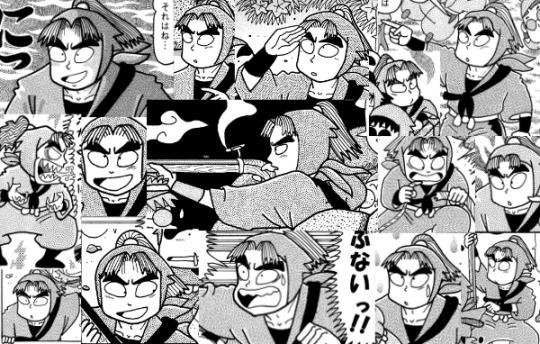
Let's take a moment to appreciate all the cool and fun expressions we get to see "Yuusaku" make when Rikichi is disguised as him.
Vol 33
Page 188
Yuusaku was cut from the anime adaptation (episode 12-67) of this chapter as well.
Some of the students of 1-Ha have noticed that Komatsuda has been unusually competent compared to usual. When the students ask Yoshino and Doi, both of them say Komatsuda's been the same as always; Komatsuda even lost the key to the explosives warehouse. Class 1-Ha goes to search for the key and ends up falling down a hole and getting hit by sleeping gas. Isuke, the last to fall asleep, finds Komatsuda kidnapping Shouzaemon.
When Isuke runs into Komatsuda after the incident, Komatsuda claims that he doesn't know anything about Shouzaemon being kidnapped. Luckily, Isuke remembers something that clues him in to the fact that the Komatsuda he saw in the hole was actually a fake. The Komatsuda he saw was wearing a uniform that had the "Clerk" tag sewn into the shirt. But during the last summer break, his family's dye shop got a request from a certain someone.
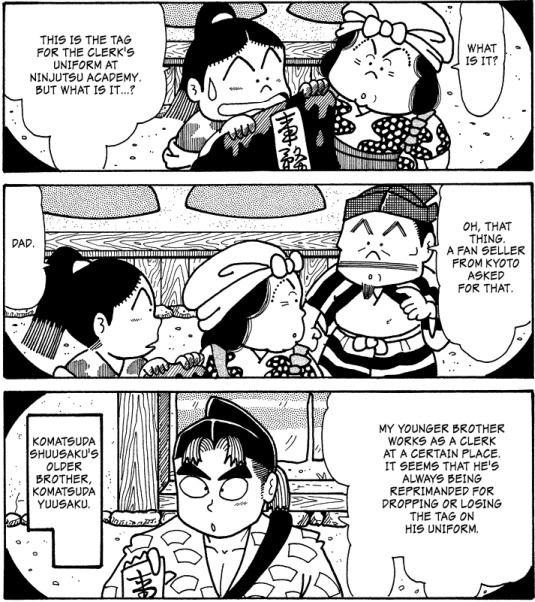
Yuusaku requested that the tag be directly dyed onto Komatsuda's uniform so the boy wouldn't have to worry about dropping and losing it. "What a sweet big brother," Isuke's mother comments - I agree.
Vol 35
Pages 43-49 (voice appears on page 52)
The anime adaptation of this chapter (episode 13-05) marks the first time Yuusaku appears in the anime - hooray!
It's summer break, and while Rantarou is in town to sell his family's rice harvest, he comes across Yoshino. Yoshino had mentioned conducting a house visit before everyone left for the break, and all the students figured the only person he could have been talking about visiting was Komatsuda. Rantarou asks if Yoshino is still going to Komatsuda's house, but Yoshino says that he's of two minds about the whole thing. Is it okay to tell Komatsuda's family that the boy isn't cut out for clerical work? Rantarou is worried that this means Komatsuda is going to be fired, so he decides to tag along with Yoshino to Komatsudaya.
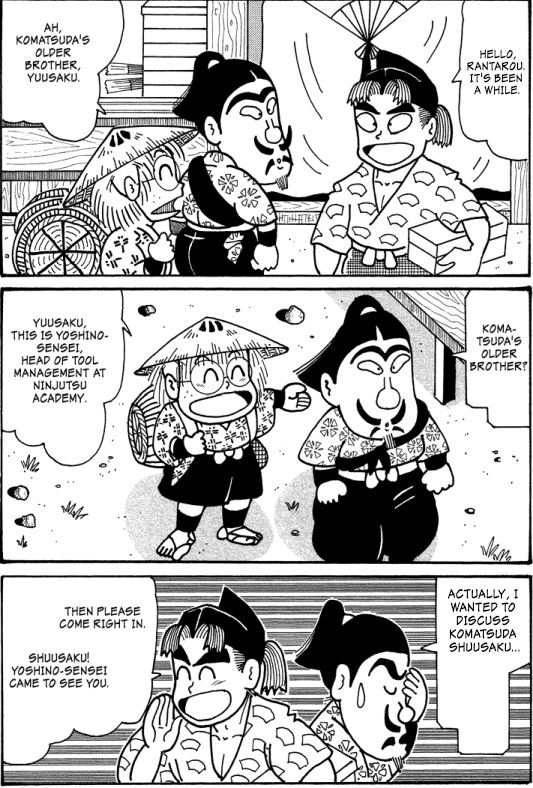

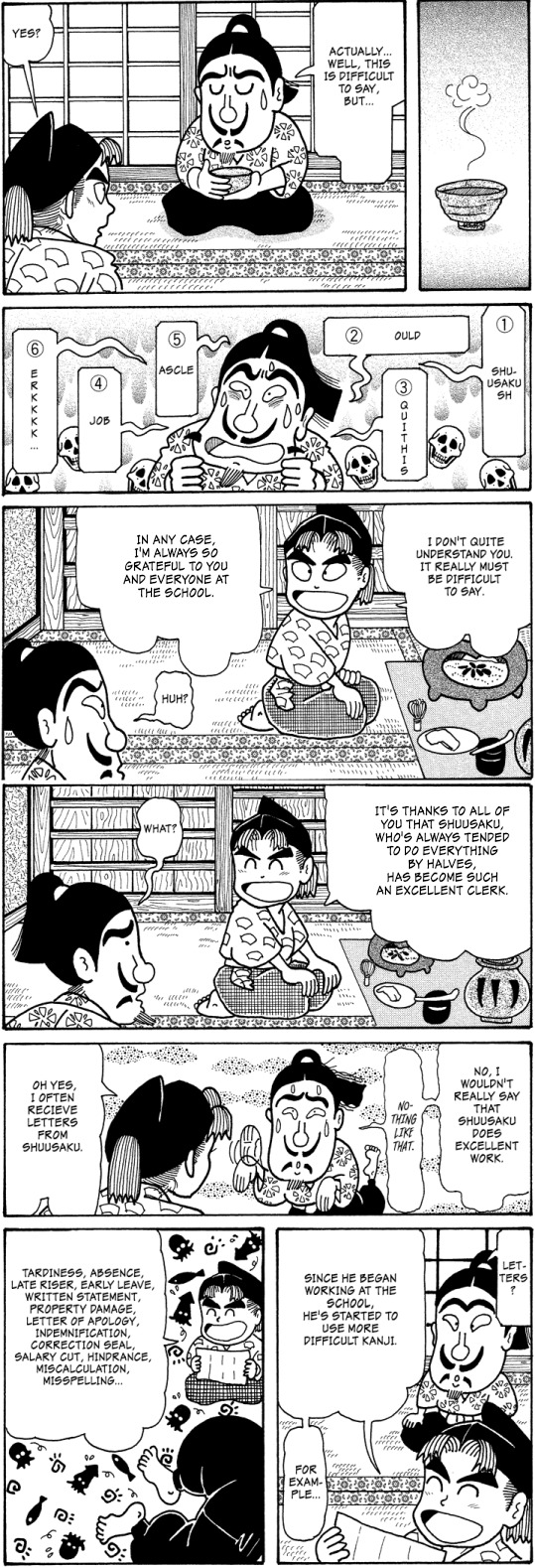

Yuusaku stays at the store, and Yoshino tells Komatsuda to get ready to head back to the school because there's plenty of preparations to take care of for the next semester. Komatsuda packs a knapsack as big as himself and is crushed under its weight. "Ah, Shuusaku," Yuusaku calls from inside, "are you okay out there?" Komatsuda, still stuck under his belongings, squeaks out, "Oniicha~n."
Vol 38
Page 240
Yuusaku is the star of this volume's 4koma.
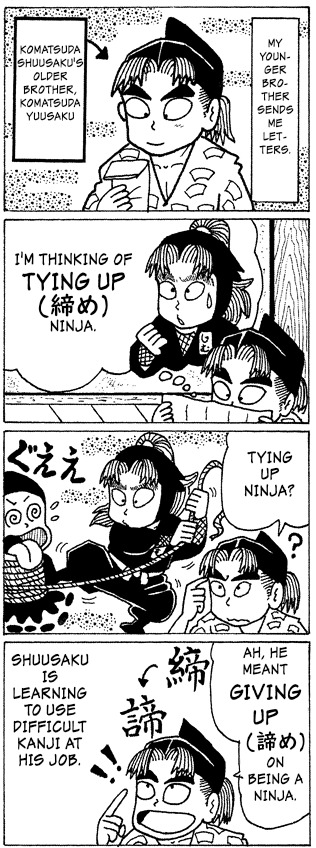
Much like how Doi learned to parse what the kids of 1-Ha say, Yuusaku can decipher what his brother means because he had plenty of practice while growing up with the boy. It takes a Komatsuda to understand a Komatsuda.
Vol 41
Pages 30, 146-147, 154, 161
Kirimaru slept through the announcement that the school's autumn break would be starting, so he didn't line up any part-time work. "Why not come work at our place for a bit?" Komatsuda offers. "If you ask my brother, I'm sure he'll hire you on for a little while." True to Komatsuda's word, Kirimaru is hired as a part-time worker for the day.
Kirimaru returns to Doi's house the next day. He mentions that the store received a strange order. To make fans, you fold the paper into a pattern that creates holes that you can then insert the bamboo frame in. However, a customer wanted a large order of separate paper and frames. Concerned, Doi asks if the store took the order.
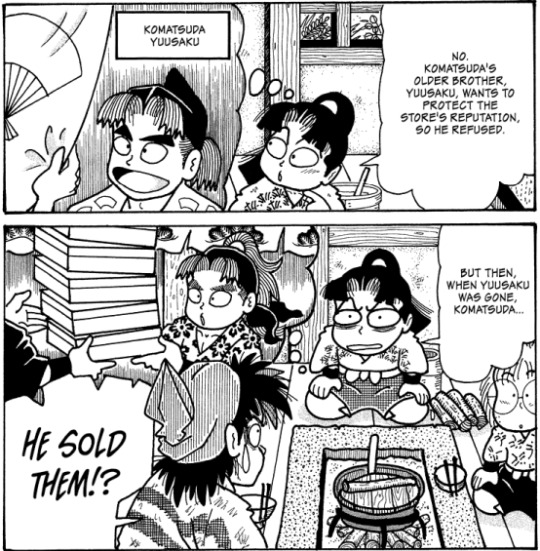
(Yuusaku appears in this chapter's anime adaptation, episode 16-02)
Doi suspects the customer was someone who plans to use the fans to perform the Kasumiougi no Jutsu, where ninja place poison inside a fan then blow the poison at their enemies. The group manages to track down the customer, a Suppontake ninja, and find out what he's scheming. It turns out the Suppontake are targeting the lord of Chamidareamitake castle. The lord goes to view the autumn leaves every year, and the place he chose to view them is in a valley whose geography would make it easy for the Suppontake to overwhelm him with poison using the Kasumiougi no Jutsu. With this information, Doi devises a plan. Why not fight fans with fans?
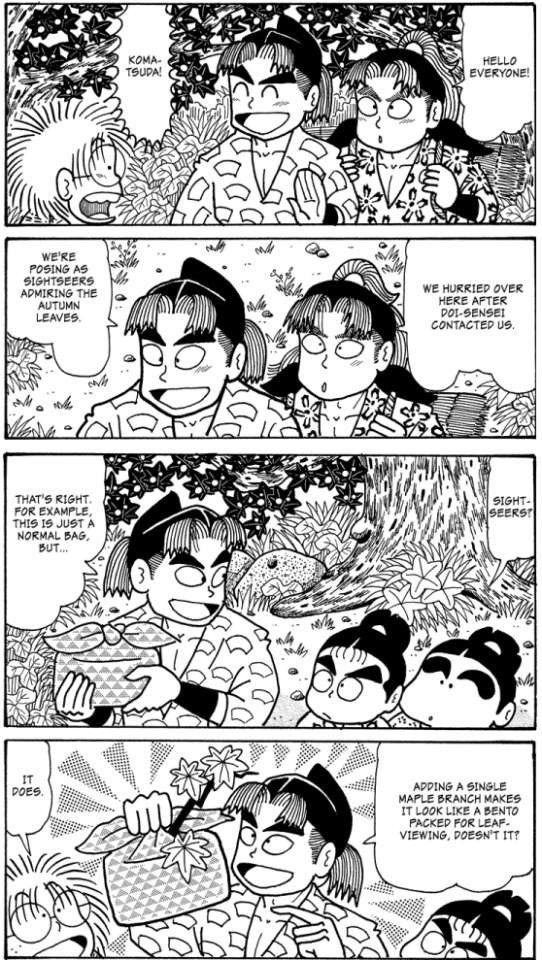
While Yuusaku is helping to sell their sightseer disguises, Komatsuda is carrying the "ultimate anti-Kasumiougi no Jutsu weapons," as Niino calls them. The brothers go with everyone to prepare for the counterattack.
The Suppontake begin their attack, though it turns out that Niino has replaced the poison in their fans with laughing gas and eye irritants. As the fumes begin to approach the valley, our heroes pull out the "ultimate weapons" that Komatsudaya made - gigantic fans that they use to blow the fumes back toward the Suppontake.
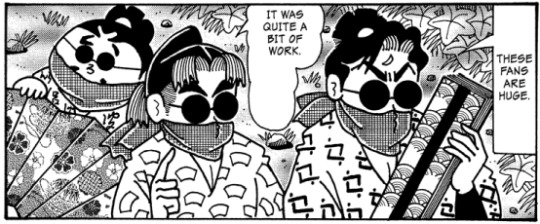
(Unfortunately, Yuusaku doesn't appear in this chapter's anime adaptations, episodes 16-23~24. He isn't even the one to make the "ultimate weapons" - Niino shows up with giant uchiwa instead. What a waste, to not have Komatsudaya's proprietor in a fan-centric series of episodes!)
The Suppontake's plans are thwarted and the day is saved! Everyone starts heading home.
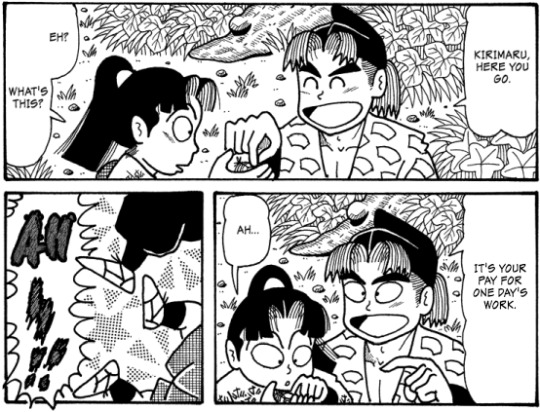
(Doi is crying out "Ah!" because he just remembered that the autumn break is ending.)
Vol 47
Pages 126, 180
Yuusaku makes two short but sweet contributions to this volume, and appears in the anime adaptations (episodes 19-28 and 19-31).
Ninjutsu Academy's cultural festival is approaching. However, when it comes time to send out invitations, Komatsuda makes a mess of all of Ninjutsu Academy's documents and ends up sending invitations to both friends and foes. But one thing is very strange, the students muse - how did Komatsuda manage to get the invitations sent out so quickly if everything was such a mess?
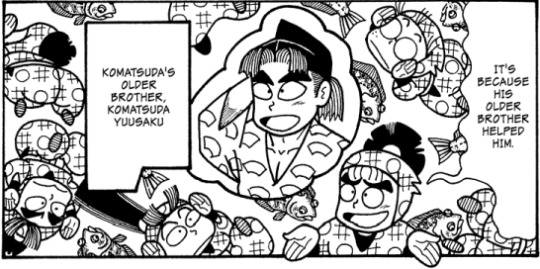
Two of the festival attendees are the assassins Masukarasu and Dosukarasu. They appear at the festival crossdressing and with fans in hand. The students worry that the assassins could have put poison inside the fans to perform the Kasumiougi no Jutsu. Saburou, however, says there's no need to worry about that. That's because…
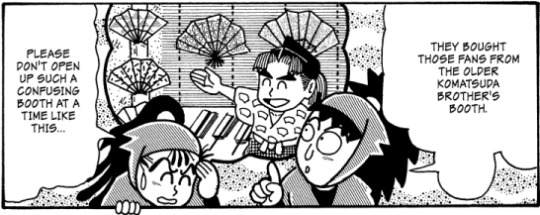
There's that entrepreneurial spirit!
Vol 65
Pages 11-15, 63-65, 67-70, 72, 82, 86, 89-90, 102, 107, 109, 119, 127, 148, 221-223, 235
(As of this writing, this volume has not been adapted for the anime.)
School is starting up again after the autumn break, and some of the 1-Ha students have met up on the road to school - where they find Yuusaku tagging along with Kirimaru and Doi. Rantarou asks what Yuusaku is doing there.
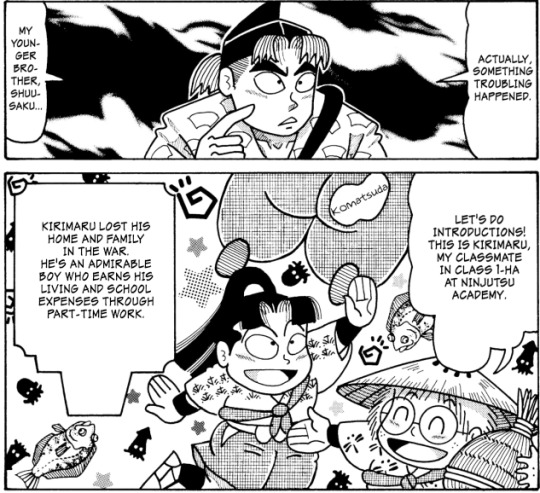
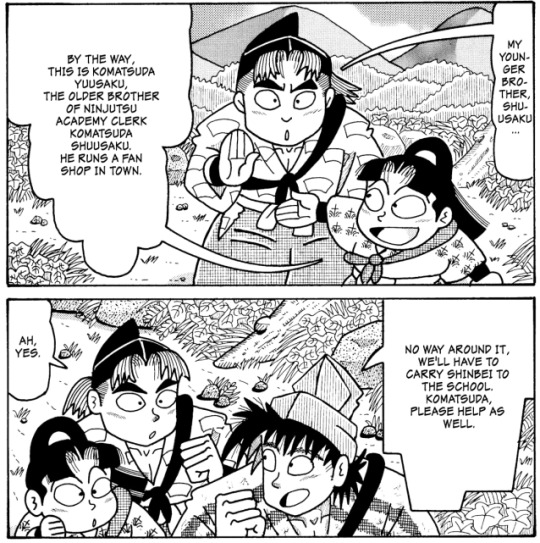
Everyone finally gets to school while carrying Shinbei, who gained too much weight on the break and had gotten too exhausted to walk anymore.
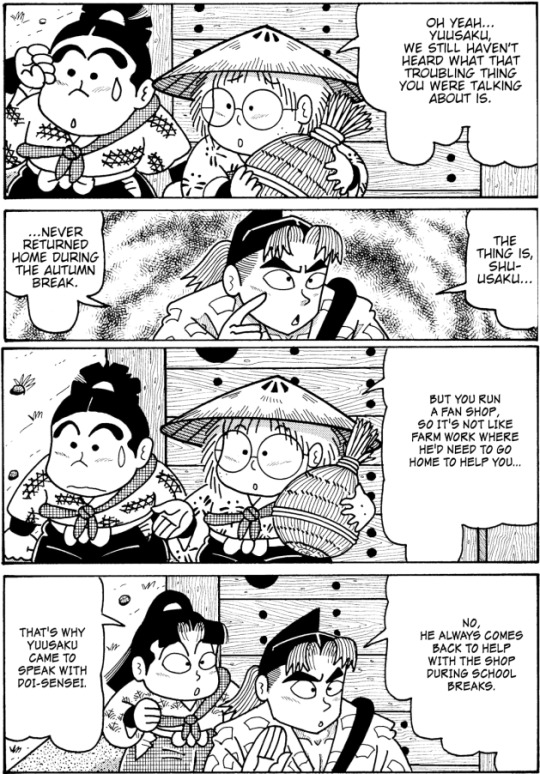
While Yuusaku waits in the staff room, the students find out what's been going on with Komatsuda. Komatsuda has become obsessed with getting people to sign in and out of the school, all day and all night, to the point where he won't even take a bath because he doesn't want to be in the tub when an intruder shows up. Even when the teachers volunteer to make the rounds, he refuses to rest and is running himself ragged.
Rantarou finally manages to get Komatsuda to go to the infirmary, where Niino gives him medicine to get him to sleep. The students and teachers will take care of any intruders that appear while Komatsuda is incapacitated.
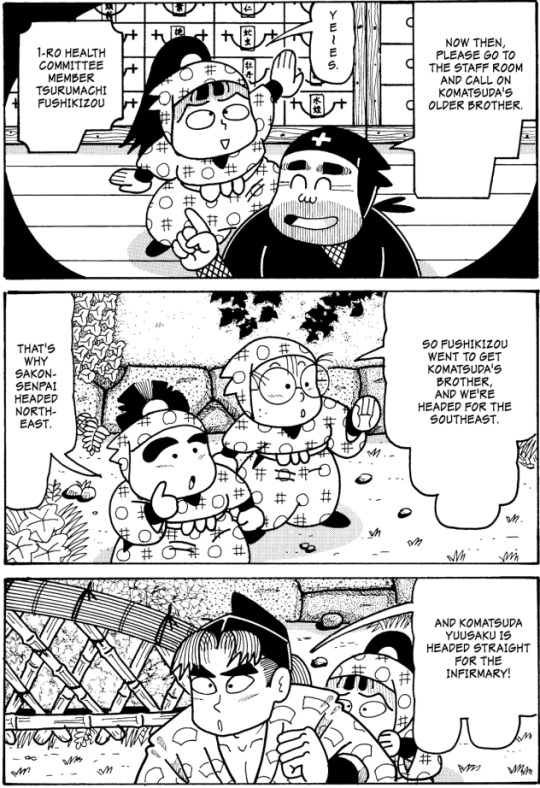
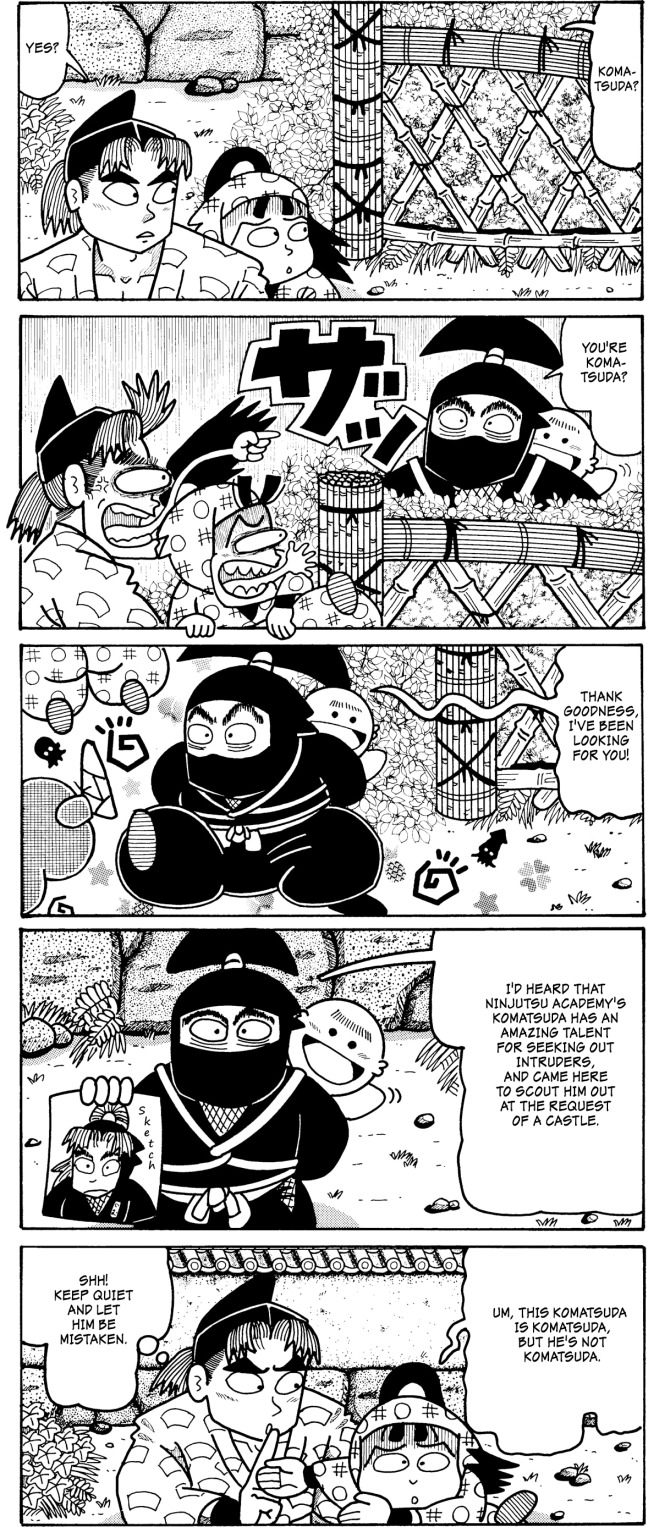
The ninja looking to scout Komatsuda is Komochi Wakana, who first appeared in volume 15. He technically already met both Komatsuda brothers, as he was one of the job-seekers in volume 32, but neither Komochi nor Yuusaku remember each other. Fushikizou says they should head to the infirmary to see Komatsuda, but Yuusaku says that going there right now is a bad idea.
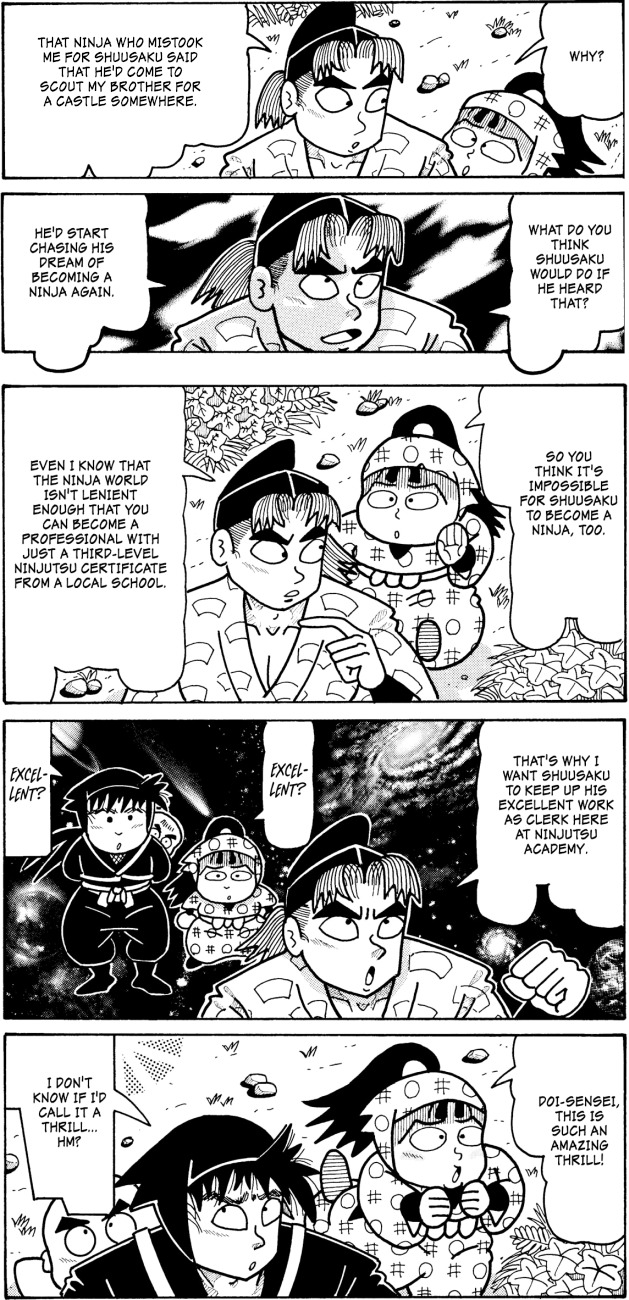
Shenanigans ensue as Sonnamon shows up to challenge Doi to a battle. Yuusaku gets to learn about ninja tools firsthand when Doi uses a urine-soaked cloth diaper to defeat Sonnamon. The main Tasogaredoki crew, who came to pick Sonnamon up, leave, but not without one last word.
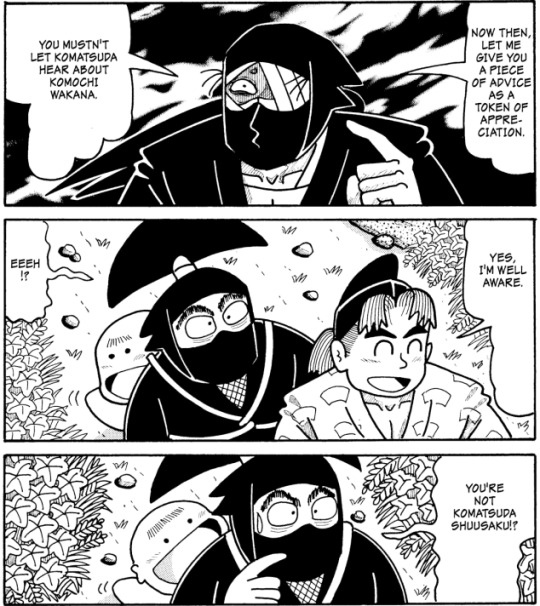
Knowing that his target is elsewhere, Komochi dashes off to find Komatsuda and complete his mission. Shinbei saves the day by using his snot to catch Komochi by the leg.
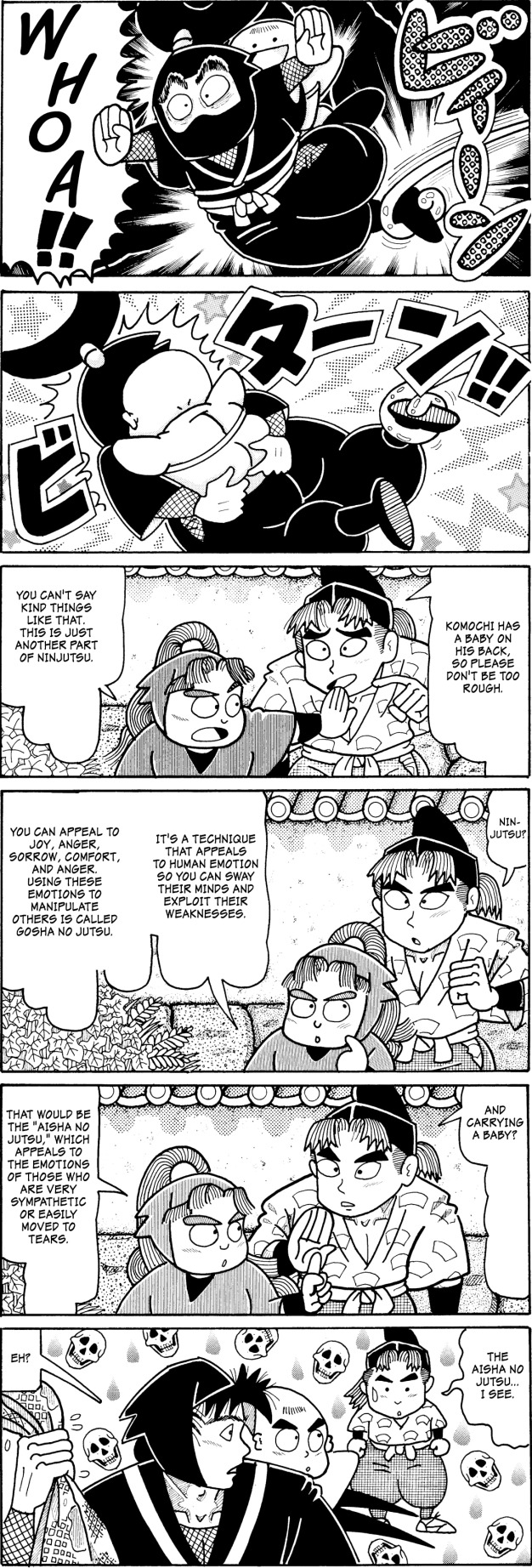
Komatsuda shows up again, having overcome the medicine he was given. Even worse, a ninja from Hidahatake castle (who'd previously judged Komatsuda's Hidahatake castle employment exam in volume 38) shows up to scout Komatsuda as well.
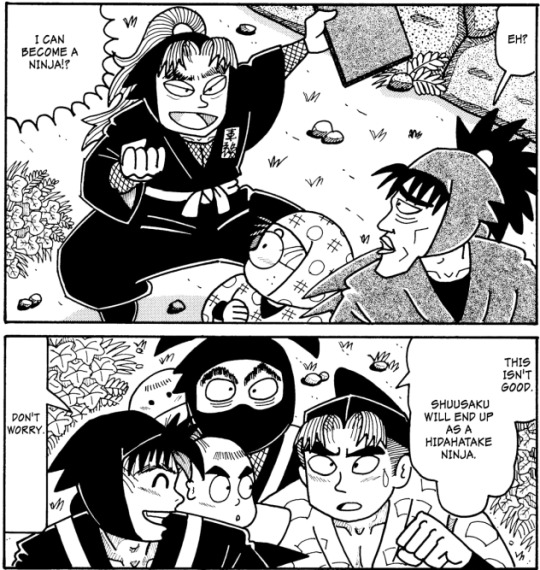
Just when Komatsuda starts to go with the Hidahatake ninja, Rantarou pulls off Komochi's hood and reveals his lusciously lipsticked mouth. Komatsuda is so surprised by the sight that he snaps out of his trance. Crisis averted!
Yuusaku continues to learn about the world of ninja, as well as why it was good that he got a name in his first appearance.
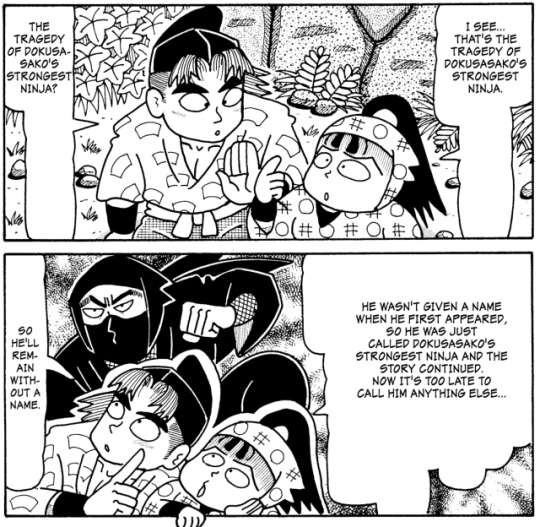
There's some hubbub as other intruders are spotted, but Yuusaku and Komatsuda are busy getting ready to return to Komatsudaya.
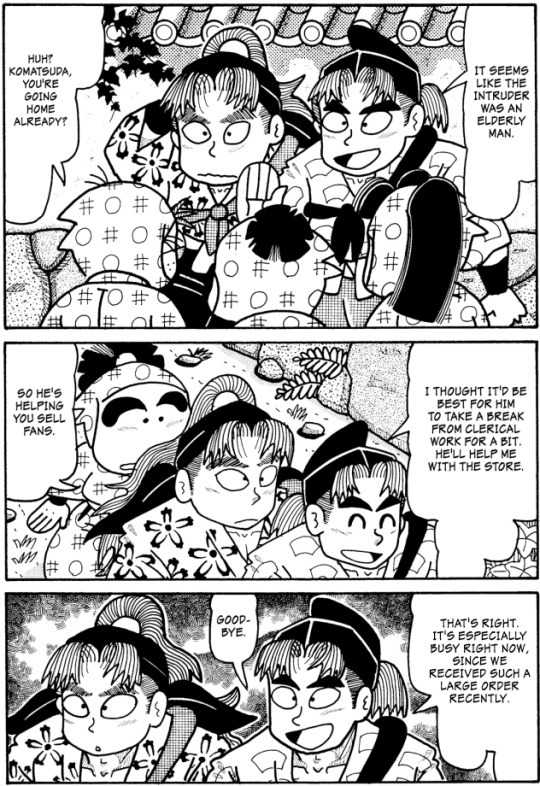
"Hey," Shinbei says after the brothers leave, "doesn't something about what Komatsuda's brother just said bother you?" If a ninja hears about someone ordering a large number of fans, of course they'll be concerned about the Kasumiougi no Jutsu. Convinced that Komatsudaya's customer is a ninja squad, everyone heads over to the store.
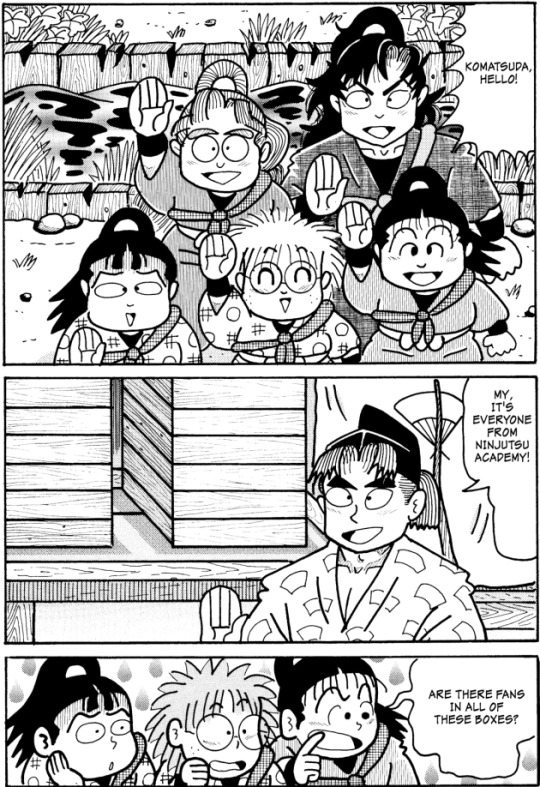
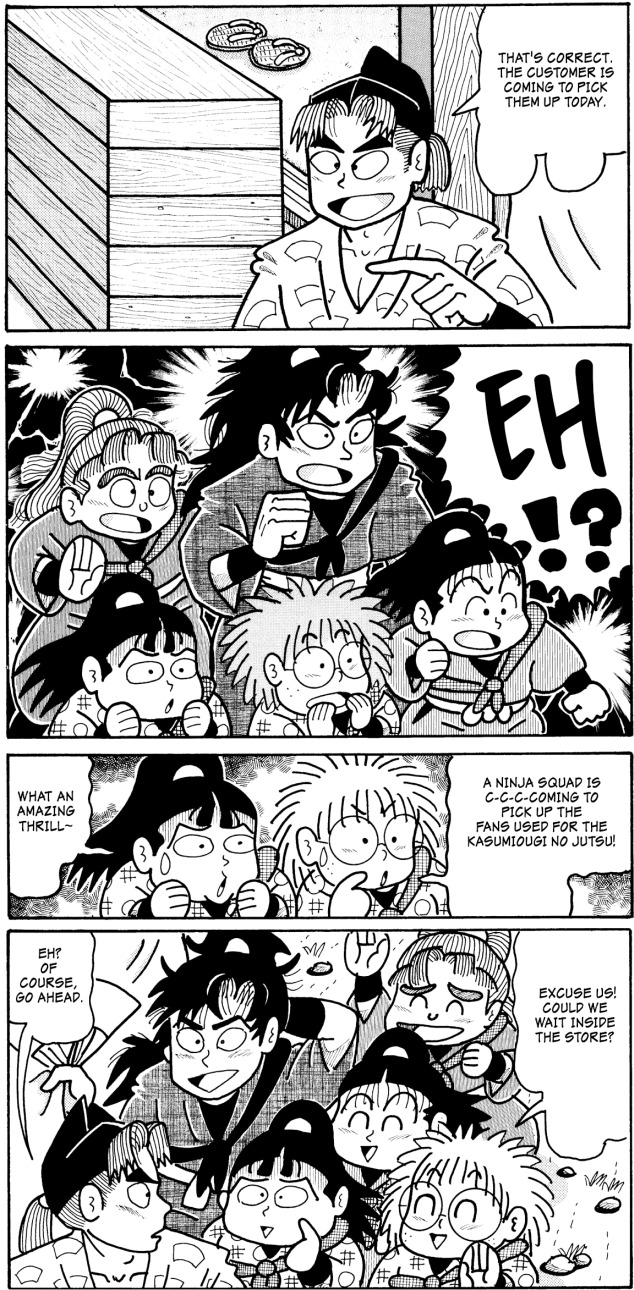
As the students stand by with bated breath, somebody approaches the store - and promptly falls into a hole that Ayabe had dug in the street. When the mysterious person is pulled out, it's none other than Shinbei's father.
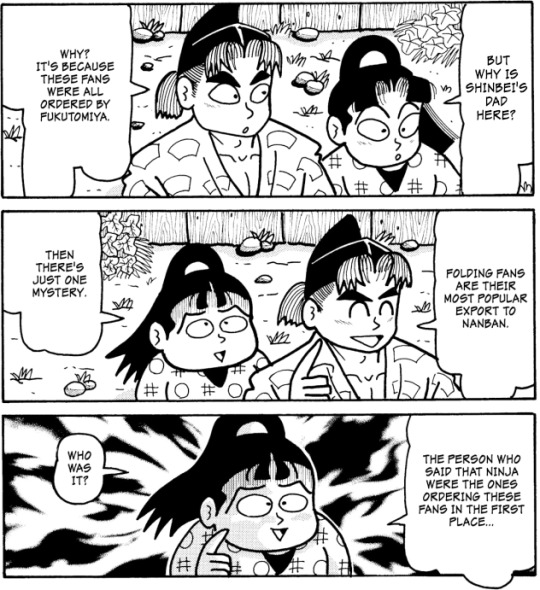
And so ends Yuusaku's appearances - as well as Rakudai Ninja Rantarou as a whole. How lucky, getting to be one of the characters to appear on the manga's last page!
I feel like I have more to personally say about Yuusaku that would make this longer than need be, so I'll probably eventually make another post. In the meantime, I hope everyone who read this enjoyed seeing more of the Komatsuda brothers.
20 notes
·
View notes
Text
❓ Kind of dropped BROKE
❓ setting aside fei lai and dragon blood for now
📖 replacing the evil way
Hoping to read/continue:
📚 poyun
📚 pi nang
📚 tgcf vol 1
📚 mingwang
📚 all for the game series
listing here my current reading list~
📖 tunhai
📖 BROKE
📖 replacing the evil way (will start)
📖 JR vol 5
📖 fei lai
thinking if I should buy:
📚 guardian vol 1
📚 tgcf vol 1
#✅ JR vol 5#✅ tunhai#�� guardian vol 1#WHICH IS MORE UNHINGED?? 188 OR ALL FOR THE GAME SERIES??#lian reads
1 note
·
View note
Text
Turn Week 2024: Day 6 - Cross-Over/International Kissing Day
I do not have anything to contribute to Cross-Overs … but I thought to capitalize on the 6th being International Kissing Day!
Kiss our dear Henriette twenty times for me.
The Marquis de La Fayette to his wife Adrienne, March 7, 1777.
Idzerda Stanley J. et al., editors, Lafayette in the Age of the American Revolution: Selected Letters and Papers, 1776–1790, Volume 1, December 7, 1776–March 30, 1778, Cornell University Press, 1977, p. 27.
Kiss our little Anastasie a million times. Alas, she is all that is left to us. I feel that my once divided fatherly affection is now completely for her; take great care of her.
The Marquis de La Fayette to his wife Adrienne, June 16, 1778
Idzerda Stanley J. et al., editors, Lafayette in the Age of the American Revolution: Selected Letters and Papers, 1776–1790, Volume 2, April 10, 1778–March 20, 1780, Cornell University Press, 1979, p. 79.
Ah, my dear heart, when shall I be close to you? When shall I be able to kiss you a hundred times?
The Marquis de La Fayette to his wife Adrienne, September 13, 1778
Idzerda Stanley J. et al., editors, Lafayette in the Age of the American Revolution: Selected Letters and Papers, 1776–1790, Volume 2, April 10, 1778–March 20, 1780, Cornell University Press, 1979, p. 173.
A thousand and thousand tender kisses for my dear Anastasie, and a big hug for George. Farewell, my love.
The Marquis de La Fayette to his wife Adrienne, May 6, 1780.
Idzerda Stanley J. et al., editors, Lafayette in the Age of the American Revolution: Selected Letters and Papers, 1776–1790, Volume 3, April 27, 1780–March 29, 1781, Cornell University Press, 1980, p. 10.
My Most Respectfull and Affectionate Compliments to Mrs. Knox; I am so impudent as to take the liberty to Adress a kiss to Lucy-and a paternal one to My Son. Adieu Yours forever
The Marquis de La Fayette to General Henry Knox, August 18, 1781.
Idzerda Stanley J. et al., editors, Lafayette in the Age of the American Revolution: Selected Letters and Papers, 1776–1790, Volume 4, April 1, 1781–December 23, 1781, Cornell University Press, 1981, p. 334.
My Best Respects Wait Upon Mrs. Knox, and Miss Lucy. I most affectionately and fatherly kiss my Son Harry.
The Marquis de La Fayette to General Henry Knox, January 8, 1784.
Idzerda Stanley J. et al., editors, Lafayette in the Age of the American Revolution: Selected Letters and Papers, 1776–1790, Volume 5, January 4, 1782‑December 29, 1785, Cornell University Press, 1983, p. 188.
My most affectionate tender Respects wait Upon Mrs Washington—I Beg she will give a kiss for me to the little girls, my friend tub
The Marquis de La Fayette to George Washington, December 21, 1784
“To George Washington from Lafayette, 21 December 1784,” Founders Online, National Archives, https://founders.archives.gov/documents/Washington/04-02-02-0167. [Original source: The Papers of George Washington, Confederation Series, vol. 2, 18 July 1784 – 18 May 1785, ed. W. W. Abbot. Charlottesville: University Press of Virginia, 1992, pp. 226–228.]
Chevalier de Caraman presents His Best Respects to Mrs Washington and to You—I kiss Squire tub, and the young ladies.
The Marquis de La Fayette to George Washington, March 19, 1785.
“To George Washington from Lafayette, 19 March 1785,” Founders Online, National Archives, https://founders.archives.gov/documents/Washington/04-02-02-0305. [Original source: The Papers of George Washington, Confederation Series, vol. 2, 18 July 1784 – 18 May 1785, ed. W. W. Abbot. Charlottesville: University Press of Virginia, 1992, pp. 449–451.]
My Best Respects Wait on Mrs. Hamilton. I kiss Phil, and the Young lady. Adieu Your affectionate friend
The Marquis de La Fayette to Alexander Hamilton, April 13, 1785.
Idzerda Stanley J. et al., editors, Lafayette in the Age of the American Revolution: Selected Letters and Papers, 1776–1790, Volume 5, January 4, 1782‑December 29, 1785, Cornell University Press, 1983, p. 318.
My Most affectionate Respects Wait upon Mrs. Knox, Miss Lucy, all the family. I kiss my God Son.
The Marquis de La Fayette to General Henry Knox, May 11, 1785.
Idzerda Stanley J. et al., editors, Lafayette in the Age of the American Revolution: Selected Letters and Papers, 1776–1790, Volume 5, January 4, 1782‑December 29, 1785, Cornell University Press, 1983, p. 322.
Adieu, my good friend, my most affectionate Respects to Mrs. Knox, and a kiss to Lucy, my Son, and the little one. Your affectionate friend
The Marquis de La Fayette to General Henry Knox, June 12, 1785.
Idzerda Stanley J. et al., editors, Lafayette in the Age of the American Revolution: Selected Letters and Papers, 1776–1790, Volume 5, January 4, 1782‑December 29, 1785, Cornell University Press, 1983, p. 330.
#turn week#turn week 2024#marquis de lafayette#la fayette#lafayette#letters#founders online#adrienne de lafayette#adrienne de noailles#georges de lafayette#anastasie de lafayette#henry knox#george washington#alexander hamilton#1777#1778#1780#1781#1784#1785#day 6#international kissing day#henriette de lafayette#french history#american history#history#american revolution#turn washington's spies
24 notes
·
View notes